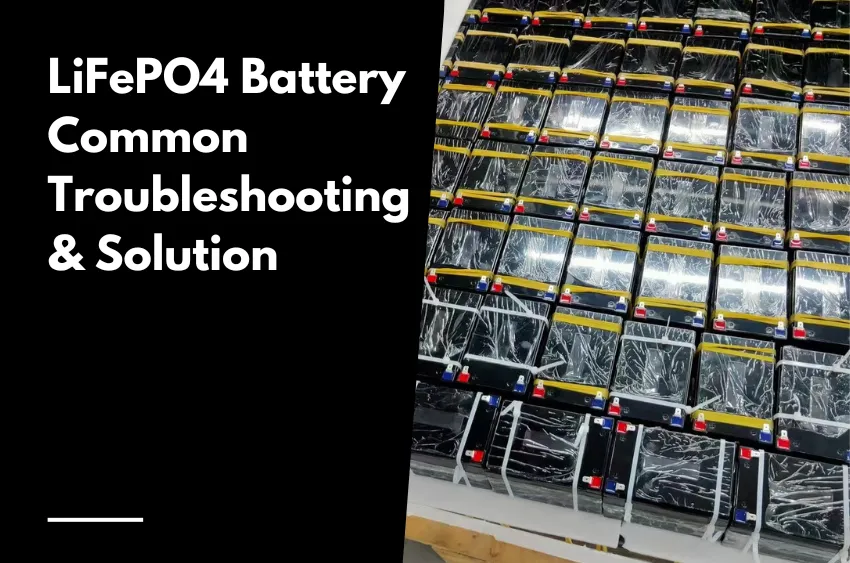Lithium Iron Phosphate (LiFePO4) batteries are popular for their high power density and safety. However, issues can still occur requiring troubleshooting. Learn how to troubleshoot common issues with Lithium Iron Phosphate (LiFePO4) batteries including failure to activate, undervoltage protection, overvoltage protection, temperature protection, short circuits, and overcurrent. Discover possible causes and solutions to maximize performance and lifetime of your LiFePO4 battery.
Battery Unable to Activate
If the battery won’t activate and allow charge/discharge over 1A, severe overdischarge is likely. Self-discharge or parasitic loads can deplete cells below 10V. Use a lithium battery charger on activation or force charge mode to revive.
Undervoltage Protection Triggered
The battery management system (BMS) cuts off discharge if the voltage drops too low, preventing cell damage. Disconnect loads immediately and charge above 1A to recover.
Overvoltage Protection Activated
Charging too high can trigger the BMS to stop charging. Disconnect the charger, reduce voltage 0.2-0.4V for 6 hours, then retry charging at proper voltage. Persistent issues may require BMS replacement.
High/Low Temperature Protection
Extreme temperatures trigger BMS protection. Disconnect the battery and cool down or warm up as needed before resuming use. The BMS will automatically reset when back in normal temperature range.
Internal Short Circuit
A short inside the battery causes high heat and current draw. Remove short as soon as possible. Charge above 1A to recover. Improve quality control to prevent internal shorts.
Overcurrent Protection
Excessive charge or discharge current will trigger BMS overcurrent protection. Immediately disconnect the battery until current returns to normal levels.
Careful monitoring and preventive maintenance keeps LiFePO4 batteries operating safely. Follow manufacturer recommended usage to maximize battery life.
The following will be presented in a list format
| Problem | Possible Causes | Solution |
|---|---|---|
• The battery is unable to be activated with a charge/discharge current greater than 1A • The battery is activated at resting voltage below 10V | Severe battery over discharge due to self-discharge or parasitic loads | Revive the battery with a battery charger or charge controller featuring lithium battery activation or force charging. |
| The battery shuts off due to undervoltage protection. | The battery voltage drops below the preset threshold | Disconnect the battery from loads, and charge the battery with a current greater than 1A as soon as possible. |
| The battery cuts off the charging current due to overvoltage protection | The battery voltage exceeds the preset threshold during charging. | 1. Disconnect the battery from the charging source. 2. Reduce charge voltage by 0.2V to 0.4V for 6 hours. 3. Attempt to fully charge the battery again with the correct voltage setting. If the problem persists with a lithium iron phosphate compatible charging source and correct voltage setting, repeat the above steps. |
| The battery temperature gets too high/low during operation and triggers high/low temperature protection. | The battery temperature exceeds the preset threshold. | 1. Disconnect the battery from the charging source or loads. 2. Cool down/Warm up the battery. 3. The battery recovers from high/low temperature protection automatically and continues operating. |
| The battery is shorted and triggers short circuit protection. | Short circuit occurs in the battery. | 1. Remove the short circuit as soon as possible. 2. Charge the battery with a current greater than 1A. |
| Charge/Discharge over-current protection is triggered due to too high current passing through the battery. | Excessive current flows through the battery during charging or discharging. | Disconnect the battery from the charging source or loads as soon as possible. |
Lithium Iron Phosphate batteries provide excellent power density and safety when used properly. However, issues can still arise during operation. By understanding common protection mechanisms and troubleshooting techniques, battery performance and lifetime can be maximized. Monitor your LiFePO4 batteries closely, respond quickly to any faults, and take preventive measures to avoid problems. With proper care and maintenance, Lithium Iron Phosphate batteries will provide reliable energy storage and power for years to come. As energy storage technology continues evolving, best practices for battery maintenance will also advance. Stay up to date on the latest recommendations, and don’t hesitate to reach out to manufacturers for battery-specific guidance. Thoughtful troubleshooting today protects your investment and ensures many cycles of safe, high-performance operation.

